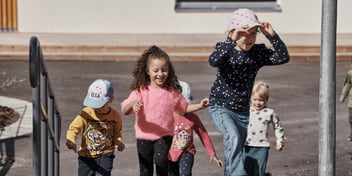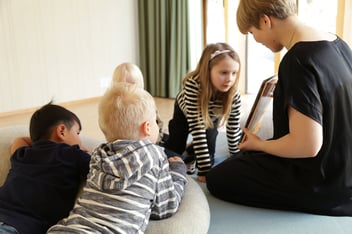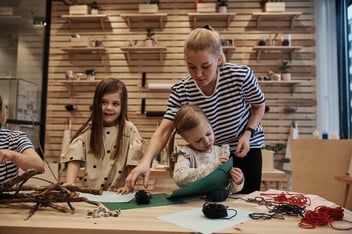6 tips for how to approach special needs in early education settings

Special needs, diversity and inclusion are all highly relevant topics for early educators, especially because the first 7 years of a child's life are crucial for their lifelong success. You may already be familiar with the concepts of special needs and inclusion, but now you’re wondering how you can observe and address special needs in your daily work with children. We're here to share some tips with you!
Special needs consist of three interconnected categories: physical and sensory impairment needs, neurodevelopmental needs and social-emotional/behavioral needs. Physical needs are usually the easiest ones to notice, especially if you're already taking a holistic approach, providing diverse opportunities for physical activity and observing the children closely as they navigate daily life. The following are some ways you can observe and address the special needs of children in ECE and foster inclusion in your setting.
Tip 1: Observe closely, but do not diagnose
Nothing beats the power of observations when it comes to discovering children's individuality. By observing the children's behavior, you will very soon start to notice their differences - what one child may be capable of doing with a few tries, another one struggles with. However, you should never attempt to make a diagnosis based on your observations; physical and neurodevelopmental special needs should always be identified by medical professionals.
Something you can do is identify why a child might have social-emotional needs, which can sometimes be due to minimal communication at home. A common problem among children in the modern world is a lack of social skills due to little or no social interaction outside the classroom. This can occur, for example, when a child is only provided with digital distractions such as a smartphone or tablet, and they have no real face-to-face communication with peers or family. Most of human interaction is non-verbal and only watching pre-recorded videos on a screen will never make up for a lack of in-person communication. If you notice a child struggling with communication, it's best to first consult the family about the child's daily routines at home. By working closely with the family and hearing about their daily life, you will see the full picture, not just the portion that occurs in your classroom, and you will be more equipped to take steps to address this type of special need.
Tip 2: Observe children regularly with tools that work for you
Regardless of the tools you use, you will see the best results when you use them regularly. Observations are not something to be done every now and then because then you will not have enough historical data to look at if you notice a change in a child's behavior or suspect they might have special needs. That’s why it is important to do it consistently. Observing is a habit that forms with time and will help you in your daily work as long as you put in the effort.
At HEI Schools Learning Centers, teachers use ready-made observation forms to write down their observations about each child in their care. They have more specific observation forms for making notes about aspects of daily life like children's strengths or their group dynamics. Teachers also fill in follow-up forms at set intervals to track the child's developmental progress in areas like their gross and fine motor skills or their emotional regulation skills. These are useful in identifying challenges if a child is not making progress in certain areas.
Tip 3: Provide a balanced mix of routines and new experiences
Humans, regardless of age, need routine, but too much routine will cause daily life to become dull. By aiming for a balance of routine and new experiences, you will have the opportunity to observe children and their responses to them: do they adapt rather quickly or do they struggle with changes? A child’s initial reaction can provide important insights into their progress and needs. Perhaps the ones who become scared could do with a little scaffolding from an adult, or they may simply want you to be close by as they navigate the new experience so they can ask questions. It is also a good idea to go over the process of building new routines with the family so that they can implement them at home.
If you notice a child continues struggling with a new routine, it is best to discuss with your teammates if they're noticing the same pattern. We are all human and each one of us have our own personal biases that can affect our observations, so it is important to confirm your observations with others. If even your teammates noticed this pattern, you should consult the family and caretakers. Do they see the same behavior at home, or does it only manifest in the school setting? If the behavior persists regardless of place and time, it may be time to consider a specialist's help because the child might have special needs that need additional support.
Tip 4: Praise children for trying, not just for end results
We are all different and unique, and we all need positive reinforcement when trying out new things, especially those of us with any sort of special needs. By focusing on the fact that a child is actively trying, you are equipping them with confidence. You're communicating that there is value in the trying, not only in the end results. Knowing that it is acceptable to fail and then try again is crucial to give children the confidence they need in the future. Praising is also known to have a positive effect on learning overall, so it is a good habit to get into regardless of children’s needs.
Tip 5: Embrace a strengths-based approach
A common approach in Finnish early education is the strengths-based approach, which is the method of focusing on a child's strengths instead of their challenges. For example, a child who has difficulties grasping numbers might be very compassionate towards their peers and display a high level of emotional intelligence. Focusing on these strengths when interacting with the child who has special needs allows them to feel pride in their abilities, which builds their confidence with enough time and repetition. When a child is confident, they are more accepting of failure from themselves and others, and because they do not fear such failure, they will eventually learn even the things they currently struggle with.
Tip 6: Collaborate closely with family and caretakers
If and when a child receives a diagnosis or definitively requires extra support for special needs, it is crucial to ensure that the support is also provided outside of the classroom. Including the family and caretakers every step of the way ensures that the child is supported regardless of their surroundings. Support at the learning center can only go so far; support needs to also be provided at home in equal, if not even greater amounts.
To kickstart an effective and trusting collaborative relationship, you should have an in-depth discussion with each child’s family in detail before they start attending your learning center. This is a common practice in Finnish early education. If meeting before the start of the school year is not possible, you can organize a separate meeting. The earlier you can meet them, the better.
Regardless of the timing, the meeting is a place where you discuss the parent's expectations, thoughts and concerns. These can be regarding the school and what they hope for their child to learn with you, what kinds of routines they have in place at home, as well as their perspective on their child's strengths and challenges. If the parents already employ a separate caretaker, like a nanny, it would be beneficial to have a discussion with them as well as they spend a lot of time with the child and might know the child’s challenges and needs for support.
In a nutshell
Special needs and inclusion is a complex topic, and what counts for a special need will depend on where you are. However, regardless of your local regulations and practices, you can always do close observations and work closely with the child's family to ensure that they receive the best early education possible when with you! Keep in mind that we all have various needs and hence one can think that every person has their own special needs!
If you and your team need training on Special Needs and Special Education, check out our Special Needs training and other teacher training options.





